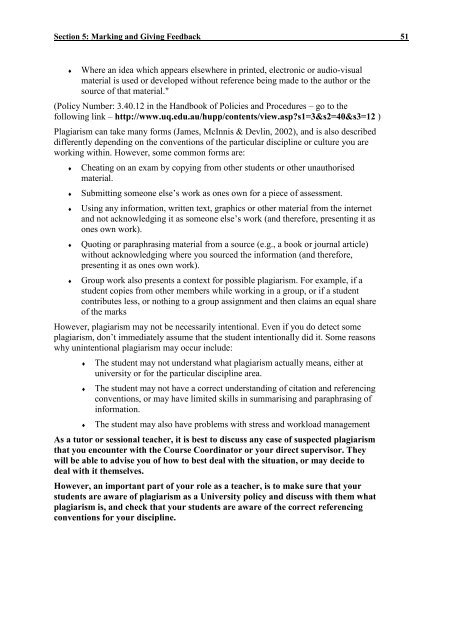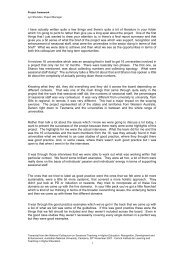A tutor's guide to teaching and learning at UQ - TEDI - University of ...
A tutor's guide to teaching and learning at UQ - TEDI - University of ...
A tutor's guide to teaching and learning at UQ - TEDI - University of ...
You also want an ePaper? Increase the reach of your titles
YUMPU automatically turns print PDFs into web optimized ePapers that Google loves.
Section 5: Marking <strong>and</strong> Giving Feedback 51♦Where an idea which appears elsewhere in printed, electronic or audio-visualm<strong>at</strong>erial is used or developed without reference being made <strong>to</strong> the author or thesource <strong>of</strong> th<strong>at</strong> m<strong>at</strong>erial."(Policy Number: 3.40.12 in the H<strong>and</strong>book <strong>of</strong> Policies <strong>and</strong> Procedures – go <strong>to</strong> thefollowing link – http://www.uq.edu.au/hupp/contents/view.asp?s1=3&s2=40&s3=12 )Plagiarism can take many forms (James, McInnis & Devlin, 2002), <strong>and</strong> is also describeddifferently depending on the conventions <strong>of</strong> the particular discipline or culture you areworking within. However, some common forms are:♦♦♦♦♦Che<strong>at</strong>ing on an exam by copying from other students or other unauthorisedm<strong>at</strong>erial.Submitting someone else’s work as ones own for a piece <strong>of</strong> assessment.Using any inform<strong>at</strong>ion, written text, graphics or other m<strong>at</strong>erial from the internet<strong>and</strong> not acknowledging it as someone else’s work (<strong>and</strong> therefore, presenting it asones own work).Quoting or paraphrasing m<strong>at</strong>erial from a source (e.g., a book or journal article)without acknowledging where you sourced the inform<strong>at</strong>ion (<strong>and</strong> therefore,presenting it as ones own work).Group work also presents a context for possible plagiarism. For example, if astudent copies from other members while working in a group, or if a studentcontributes less, or nothing <strong>to</strong> a group assignment <strong>and</strong> then claims an equal share<strong>of</strong> the marksHowever, plagiarism may not be necessarily intentional. Even if you do detect someplagiarism, don’t immedi<strong>at</strong>ely assume th<strong>at</strong> the student intentionally did it. Some reasonswhy unintentional plagiarism may occur include:♦♦♦The student may not underst<strong>and</strong> wh<strong>at</strong> plagiarism actually means, either <strong>at</strong>university or for the particular discipline area.The student may not have a correct underst<strong>and</strong>ing <strong>of</strong> cit<strong>at</strong>ion <strong>and</strong> referencingconventions, or may have limited skills in summarising <strong>and</strong> paraphrasing <strong>of</strong>inform<strong>at</strong>ion.The student may also have problems with stress <strong>and</strong> workload managementAs a tu<strong>to</strong>r or sessional teacher, it is best <strong>to</strong> discuss any case <strong>of</strong> suspected plagiarismth<strong>at</strong> you encounter with the Course Coordina<strong>to</strong>r or your direct supervisor. Theywill be able <strong>to</strong> advise you <strong>of</strong> how <strong>to</strong> best deal with the situ<strong>at</strong>ion, or may decide <strong>to</strong>deal with it themselves.However, an important part <strong>of</strong> your role as a teacher, is <strong>to</strong> make sure th<strong>at</strong> yourstudents are aware <strong>of</strong> plagiarism as a <strong>University</strong> policy <strong>and</strong> discuss with them wh<strong>at</strong>plagiarism is, <strong>and</strong> check th<strong>at</strong> your students are aware <strong>of</strong> the correct referencingconventions for your discipline.



